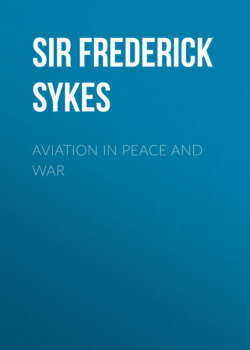Aviation in Peace and War

Реклама. ООО «ЛитРес», ИНН: 7719571260.
Оглавление
Sir Frederick Hugh Sykes. Aviation in Peace and War
Aviation in Peace and War
Table of Contents
INTRODUCTION
CHAPTER I
PRE-WAR
Early Thoughts on Flight
The Invention of the Balloon
First Experiments in Gliders and Aeroplanes
The Wright Brothers and their Successors in Europe
The First Airships
The Beginnings of Aviation in England
The Inception and Development of Aircraft as Part of the Forces of the Crown
The Balloon Factory
The Air Battalion
The Royal Flying Corps
The Military Wing
The Naval Wing
Tactics and the Machine
Conclusions
CHAPTER II
WAR
General Remarks on War Development
Co-operation with the Army
Reconnaissance
Photography
Wireless
Bombing
Contact Patrol
Fighting
Co-operation with the Navy
Coast Defence, Patrol and Convoy Work
Fleet Assistance, Reconnaissance, Spotting for Ships' Guns
Bombing
Torpedo Attack
Home Defence
Night Flying and Night Fighting
The Machine and Engine
Tactics and the Strategic Air Offensive
Organization
CHAPTER III
PEACE
The Future of Aerial Defence
Civil Aviation as a Factor in National Security
Civil Aviation as an Instrument of Imperial Progress
Financial and Economic Problems
Weather Conditions and Night Flying
Organization
The Machine and Engine
Air Services: British, Continental and Imperial
CONCLUSION
Отрывок из книги
Sir Frederick Hugh Sykes
Published by Good Press, 2019
.....
In 1890 a balloon section was introduced into the Army as a unit of the Royal Engineers, and not long afterwards, the Balloon Factory was established at South Farnborough, where in 1912 it was transformed into the Royal Aircraft Factory. Four balloon sections took part in the South African War and were used during the Siege of Ladysmith, at Magersfontein and Paardeburg. Colonel Lynch, who served in the Boer Army, stated at a lecture delivered in Paris after the war that "the Boers took a dislike to balloons. All other instruments of war were at their command; they had artillery superior for the most part to, and better served than, that of the English; they had telegraphic and heliographic apparatus; but the balloons were the symbol of a scientific superiority of the English which seriously disquieted them."
I went through a course in ballooning during leave from West Africa in 1904 and remember that partly owing to the energy of Colonel Capper, partly to the impetus given by the South African War, and partly to the growing interest in all things aeronautical throughout the civilized world, it was noticeable that the activities of the Balloon Factory were increasing in many directions. Although the spherical balloon had been improved, its disabilities were recognized and experiments were made with elongated balloons, man-flying kites, air photography, signalling devices, observation of artillery fire, mechanical apparatus for hauling down balloons, and petrol motors. A grant for a dirigible balloon was obtained in 1903, though it was not until 1907, the year in which Cody began the construction of his aeroplane at Farnborough, and Charles Rolls his experiments, that the airship "Nulli Secundus" made her first flight. She was about 120 feet long and 30 feet in diameter, and was driven by a 40 horse-power engine at a speed of 30 miles an hour. On October 5th this airship flew to London in an hour and a half, circled round St. Paul's, manœuvred over Buckingham Palace, and descended at the Crystal Palace. In the same year, be it remembered, a Zeppelin had made a trip of 200 miles from Friedrichshaven to Frankfort. The "Nulli Secundus" was followed in 1910 by the "Beta" and the "Gamma."
.....